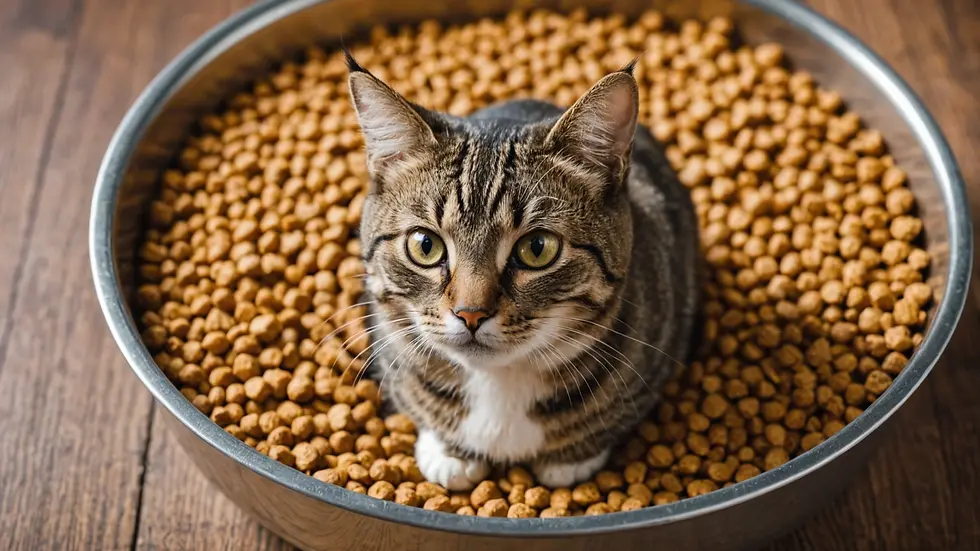Optimizing Breeding Season Performance: Best Management Practices for Cat Breeders
- Jyotiraj Borah
- Feb 11
- 4 min read
Breeding cats can be a fulfilling experience, yet it also brings a unique set of challenges. Successfully managing the breeding season is crucial for cat breeders wanting to enhance performance and ensure the well-being of their animals. Every detail matters, from timing the breeding cycles to providing care for the pregnant queen. This guide aims to equip breeders with practical strategies that can lead to positive outcomes while prioritizing the health of the cats.
Understanding the Breeding Cycle
A solid understanding of the feline reproductive cycle is key to effective breeding season management. Cats are known to be seasonally polyestrous, which means they can have several heat cycles throughout the breeding season.
Ovulation and Heat Cycles
Female cats usually enter heat, also known as estrus, as spring days become longer. Signs of estrus include loud vocalizations, increased affection, and a characteristic posture known as lordosis. Understanding these signals is essential for planning successful matings. Typically, a female can enter heat every two to three weeks, with successful mating most likely during her first or second heat cycle.
Estrous Cycle Phases
The reproductive cycle of cats consists of four phases:
Proestrus: This phase lasts about 1-2 days. The queen begins to attract male cats but is not yet receptive.
Estrus: The prime mating phase, lasting 4-6 days, where the queen is fertile and likely to mate several times.
Metestrus/Diestrus: Following mating, this phase brings hormonal changes and the opportunity for pregnancy.
Anestrus: During colder months, reproductive activity significantly decreases.
Breeders can use a breeding calendar to track these phases effectively, ensuring that matings are timed optimally.
Nutrition and Health Management
Proper health care is vital for both the queen and the tom during the breeding season. Nutrition significantly impacts reproductive health and the overall success of breeding.
Feeding Pregnant Queens
Pregnant queens should shift to a high-quality, nutrient-dense diet tailored for pregnant or nursing cats. This dietary change is vital as their caloric needs can increase by up to 25-50% during this time. Ingredients rich in protein, healthy fats, vitamins, and minerals are crucial. Always provide fresh water, as hydration is critical for supporting the health of the queen and her developing kittens.
Regular Veterinary Check-ups
Routine veterinary check-ups should be scheduled before, during, and after breeding. Ensuring that both the queen and tom are vaccinated and free from parasites is essential for minimizing health risks. Identifying any underlying health concerns early can prevent complications during breeding.

Environmental Considerations
Many breeders overlook the importance of a suitable breeding environment, yet it can significantly influence breeding success.
Creating a Comfortable Space
Breeders should ensure the breeding area is peaceful and secure. This environment should be equipped with comfortable bedding, allowing the queen to feel at ease. Providing a calm space reduces stress, which can hamper successful matings.
Minimizing Stressors
It's essential to limit the queen’s exposure to loud noises and unfamiliar pets during the breeding season. Stress can interfere with her behavior and receptiveness. In multi-pet households, consider separating the breeding pair to maintain a tranquil atmosphere.
Behavioral Management
Understanding feline behavior during the breeding season can improve interactions between the queen and the tom.
Introducing the Tom
Introduce the tom to the queen gradually. Providing both cats with opportunities to explore each other's scent can make direct interactions smoother. This helps reduce anxiety and fosters a more comfortable environment for both cats.
Monitoring Mating Behavior
As mating takes place, monitoring for aggression is important. While mating is natural, ensuring that both animals are safe is critical. If any signs of aggression appear, separating the cats may be necessary.
Care During Pregnancy
After successful mating, providing care for the pregnant queen becomes the top priority.
Pregnancy Duration and Signs
The gestation period for cats typically lasts between 63 and 65 days. Common signs of pregnancy include weight gain, an increase in appetite, and behavioral changes like nest-building.
Preparing for Kittens
As the due date approaches, it’s vital to prepare a clean and quiet whelping area for the queen. This safe space should contain soft bedding, and it should be easy for her to access food and water.
Post-Whelping Care
After the kittens arrive, both the mother and her offspring need careful attention.
Nutrition for Nursing Queens
Lactating queens require a diet high in calories. Switching to a premium kitten food helps meet these needs and supports the growth of the kittens.
Socializing Kittens
Early socialization is essential for developing well-rounded adult cats. Regular interaction with humans and exposure to varied experiences will help them adapt better as they grow.
Health Check-ups for Kittens
Schedule vet appointments for the kittens around 6-8 weeks of age. These visits are crucial for vaccinations and overall assessments to ensure healthy development.
Record Keeping and Documentation
Comprehensive record-keeping is key for responsible cat breeding. Maintain detailed breeding records to track the dates of breeding, heat cycles, and health status for both the queen and tom.
Database Management
Using a spreadsheet or simple database can streamline tracking of important information. Regular updates will contribute to better management in future breeding seasons.
Understanding Lineage
Recording the genetic history of cats is also crucial. Keeping detailed records can help breeders make informed choices that minimize the risk of future health problems.
Considerations for Successful Breeding
Managing the breeding season for cats involves a thorough understanding of their reproductive behaviors, proper nutrition, and a supportive environment. By implementing the practices noted in this guide, breeders can optimize all aspects of breeding while ensuring the health of both cats and kittens.
This journey in breeding cats comes with significant responsibilities. With careful planning, proactive measures, and ongoing education, cat breeders can turn their experience into a rewarding adventure.





Comments